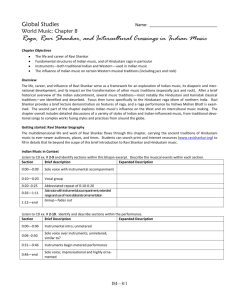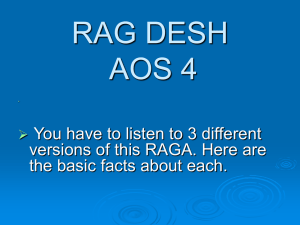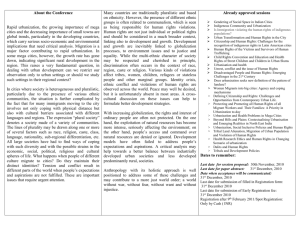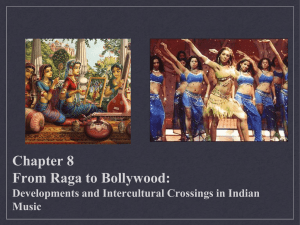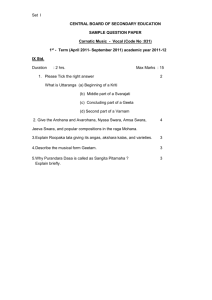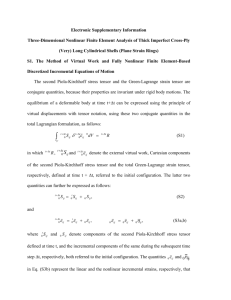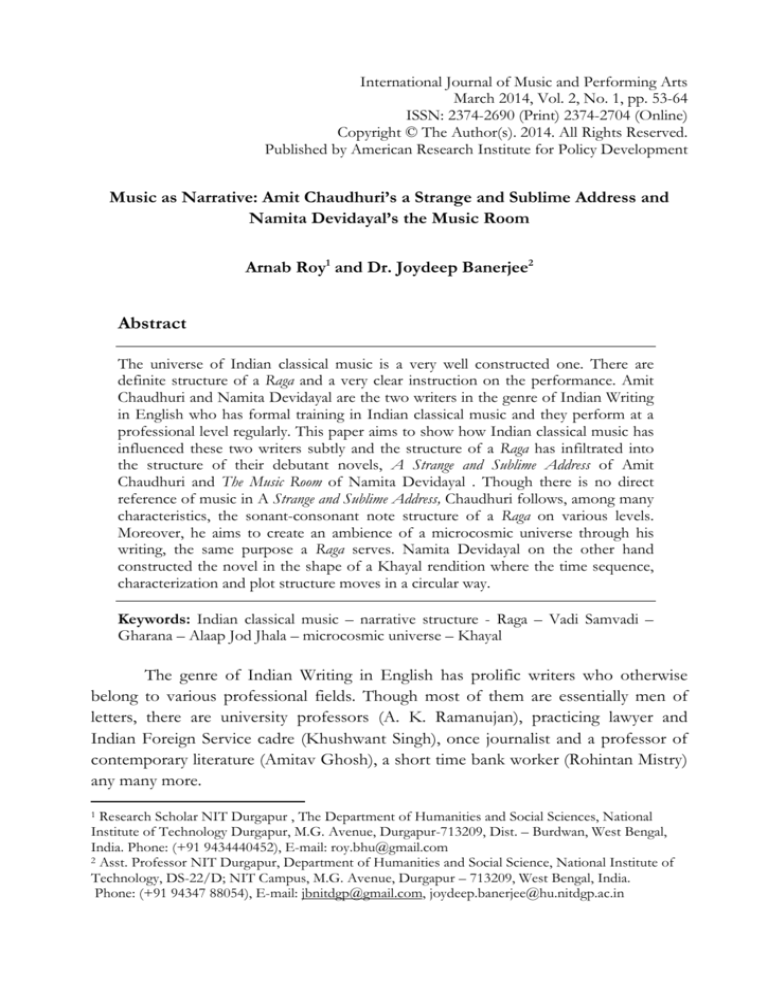
International Journal of Music and Performing Arts
March 2014, Vol. 2, No. 1, pp. 53-64
ISSN: 2374-2690 (Print) 2374-2704 (Online)
Copyright © The Author(s). 2014. All Rights Reserved.
Published by American Research Institute for Policy Development
Music as Narrative: Amit Chaudhuri’s a Strange and Sublime Address and
Namita Devidayal’s the Music Room
Arnab Roy1 and Dr. Joydeep Banerjee2
Abstract
The universe of Indian classical music is a very well constructed one. There are
definite structure of a Raga and a very clear instruction on the performance. Amit
Chaudhuri and Namita Devidayal are the two writers in the genre of Indian Writing
in English who has formal training in Indian classical music and they perform at a
professional level regularly. This paper aims to show how Indian classical music has
influenced these two writers subtly and the structure of a Raga has infiltrated into
the structure of their debutant novels, A Strange and Sublime Address of Amit
Chaudhuri and The Music Room of Namita Devidayal . Though there is no direct
reference of music in A Strange and Sublime Address, Chaudhuri follows, among many
characteristics, the sonant-consonant note structure of a Raga on various levels.
Moreover, he aims to create an ambience of a microcosmic universe through his
writing, the same purpose a Raga serves. Namita Devidayal on the other hand
constructed the novel in the shape of a Khayal rendition where the time sequence,
characterization and plot structure moves in a circular way.
Keywords: Indian classical music – narrative structure - Raga – Vadi Samvadi –
Gharana – Alaap Jod Jhala – microcosmic universe – Khayal
The genre of Indian Writing in English has prolific writers who otherwise
belong to various professional fields. Though most of them are essentially men of
letters, there are university professors (A. K. Ramanujan), practicing lawyer and
Indian Foreign Service cadre (Khushwant Singh), once journalist and a professor of
contemporary literature (Amitav Ghosh), a short time bank worker (Rohintan Mistry)
any many more.
1
Research Scholar NIT Durgapur , The Department of Humanities and Social Sciences, National
Institute of Technology Durgapur, M.G. Avenue, Durgapur-713209, Dist. – Burdwan, West Bengal,
India. Phone: (+91 9434440452), E-mail: roy.bhu@gmail.com
2 Asst. Professor NIT Durgapur, Department of Humanities and Social Science, National Institute of
Technology, DS-22/D; NIT Campus, M.G. Avenue, Durgapur – 713209, West Bengal, India.
Phone: (+91 94347 88054), E-mail: jbnitdgp@gmail.com, joydeep.banerjee@hu.nitdgp.ac.in
54
International Journal of Music and Performing Arts, Vol. 2(1), March 2014
It has often been observed that the professional curiosity has infiltrated into
the writing of an author in a subtle way. However, when we look at the entire oeuvre
of Indian Writing in English, we get a handful of writers who has inclination towards
music. Among them, Amit Chaudhuri and more recently Namita Devidayal are the
two writers who have received regular serious training of Indian Classical Music. Both
of them, despite their professional preoccupations (as Amit Chaudhuri is a professor
of contemporary literature at the University of East Anglia and Namita Devidayal is a
journalist with Times of India) give vocal performances at a professional level
regularly.
When these two writers ventured into the realm of fictional prose for the first
time, Indian classical music was more than an influence on them; rather it subtly
moulded the structure of the novel. In Amit Chaidhuri’s case, it is A Strange and
Sublime Address (1991) and Namita Devidayal’s first novel is The Music Room (2007).
Amit Chaudhuri has learnt North Indian classical music from late Pandit
Govind Prasad Jaipurwale of the Kunwar Shyam Gharana (1) and was also guided in
Hindustani music by Pandit A. Kanan. To quote his official Website, “Amit
Chaudhuri is a trained and classically acclaimed singer in the north Indian classical
tradition; he has received high praise for his singing from various newspapers and
journals, including the Times of India, the Hindustan Times, Ananda Bazar Patrika and
India Today.” (Chaudhuri, official website, profile).Chaudhuri himself writes in his
book Telling Tales, “..by the time I reached London, (2) my musical propensities has
taken an unexpected turn : I’d discovered the beauty and difficulty of Indian classical
vocal music, and began an arduous regime of training.” (256). Not only that, in an
interview published in The Hindu Amit Chaudhuri asserted, “I experienced my
‘Indianness’ as something that expressed itself powerfully through Hindustani classical
music.” (The Hindu, December, 25- 2010). All these were happening to him when he
was writing A Strange and Sublime Address. In another interview published in India
International Centre Quarterly, Chaudhuri told to Anita Roy:
When I started writing my first novel on 1986, just five years after Midnight’s Children
was published,…I was myself trying to escape from other forms— the whole burden of
absurdist and existentialist discourse which was such a big thing in ‘70s, creating prisms
through which one saw everything.(Roy, “A Conversation With Amit Chaudhuri”. India
International Centre Quarterly, 153)
Roy & Banerjee
55
So Chaudhuri had to look for another forms of narrative structure. Music,
especially Indian classical music was definitely his forte and he was quite sure of his
ability. Chaudhuri later writes in Telling Tales :
When I think of how I make my daily journey from writing to music, and back again
(Which, in a sense, I’m enacting at the moment), I grope for analogies. It is not a question of
being able to ‘do’ various things. I can cite two roughly analogous activities: global travel
(which has defined my life for about thirty years); and writing bilingually.” (257).
As for Namita Devidayal, she had had the privilege of learning music from
‘gaanjogini’ Smt Dhondutai Kulkarni and to become a part of the exquisite lineage of
the famous and one of the oldest of the Gharanas, Jaipur-Atrauli Gharana. Dhondutai,
who is a singer of her own stature, learnt from Ustad Natthan Khan, Ustad Manji
Khan and Ustad Bhurji Khan (sons of Ustad Alladiya Khan, the founder of the
Gharana. She is also the sole disciple of legendary Smt Kesarbai karkar. The Music Room
(2007) is an account of Devidayal’s life-long traditional and rather unconventional
‘guru-shisya’ relationship and musical journey with Dhondutai Kulkarni that expands
for not less than three decades. In her own words, “I think the book was a coming
together of my two greatest passions – music and writing” (Tiwari, Mirror, Sept. 30,
2007). Because the world of art is “a very difficult, very painful world” (Ibid.) as, she
clarifies, “ it demands tremendous dedication. And I really didn’t have it in me. To
me, this book is, in a way, my tribute to what I wasn’t able to do musically.”
(Someshwar, Pain and Struggle, rediff news, September 20, 2007). As far as the structure
of the novel is concerned, Devidayal herself admitted in a rather amused way, “The
funny thing is that the structure of the book unwittingly ended up being like a khayal
rendition— lovely detours which always come back to the sama or point of beginning
in the table cycle” ( Tiwari, Mirror, Sept.30, 2007).
From his very first novel, Amit Chaudhuri has secured a distinguished
position in terms of narrative technique. Much has been said about the lyrical quality
of his prose.
Prof. S.B. Shukla and Anu Shukla writes in, The Novels of Amit Chaudhuri: An
Exploration in the Alternative Tradition, “he becomes lyrical rather than specific or
realistic” (Shukla, 4). He has been famously termed as the master of miniature by the
critics.
56
International Journal of Music and Performing Arts, Vol. 2(1), March 2014
Chaudhuri himself commented in the introduction of Picador Book of Modern
Indian Literature, “Post-Rushdie, the Indian novel in English has been constructed, in
both popular and critical terms, as something distinct from— indeed, as an alternative
to – the conventional English novel.” (Chaudhuri, 2001, Introduction XXV). Standing
aside from the ‘robustly extroverted’ (Chaudhuri’s term, Introduction XXV.) style of
Rushdie and most of the Post-Rushdie Indian novelists in English, Chaudhuri’s
novels can be termed as ‘fiction of sensibility’. (Dhar, “Amit Chaudhuri and the
Fiction of Sensibility”,Shukla, 38).
Amit Chaudhuri’s first novel ‘A Strange and Sublime Address’ (1991) is the story
of young Sandeep and his two visits (with a gap of one and half year between them)
to his Chhotomama’s (maternal uncle) house in Southern part of Calcutta (Calcutta
then, now Kolkata) from Bombay (not Mumbai, again). These visits are source of
immense pleasure to him as he spends the entire time playing and enjoying with his
two cousins, Abhi and Babla. Through these visits, he gets acquainted with the
universe of the adults and with the Bengali culture in his own childish ways. The
ambience of the house and its surroundings is definitely very different from the highrise apartment he lives in Bombay. During their second visit, Chhotomama had two
consecutive heart attacks, which he eventually survived. The story ends when the
doctor was about to release Chhotomama from hospital and the boys were playing at
the garden adjacent to the hospital and were looking for a ‘kokil’ bird. Though there
is not much reference to any Raga in this novel [except once towards the end of the
novel where Sandeep is coming back from the hospital with his family and Raga
Bhairavi or Shankara is being played in Shehnai at a marriage hall.(116)], the structure of
A Strange and Sublime Address subtly follows the structure of a Raga.
The first and foremost function of a Raga is to create an ambience, a particular
mood. It is also well accepted that a particular Raga evokes or represents particular
season (i.e. all the Ragas of Malhar group are played for Rainy season or Raga Basanta is
for Spring.) There are also definite directions about which Raga can be played at a
certain Prahar (Part of the day), i.e. Bhairavi is a morning Raga that is supposed to be
played at dawn or evoke a feeling of dawn into the audience.(3)
Now in A Strange and Sublime Address Chaudhuri is very particular about
providing a minute and often microcosmic description of a particular season or part
of the day. A sudden splash of rain comes after long hot summer days. Chaudhuri
describes :
Roy & Banerjee
57
On Saturday, a cool breeze surprised them. It smelled of wet earth,
sodden leaves. It had rained somewhere in the villages, in the groves and fields,
and the breeze had travelled to this lane, bringing news of rain from the far-off
place of its beginnings. They had congregated after lunch on the double bed on
the second storey, when it ran its fingers down their backs, making them break
out in goose-flesh. There was something erotic about the first breeze that
brought the monsoons. (66)
Then again he goes on: it was the most beautiful movement seen on this
rainy day. Crows hopped alertly. They sensed a presence, powerful and
dangerous, though they could see nothing or no one. The nervous toy like city
was set against the dignified advance of the clouds, as if two worlds were
colliding. There was an end-of-the-world atmosphere.( 67).
Midday is the favourite part of the day to Chaudhuri. The description of
noontime household, the interplay of light and shadow, the heat, come repeatedly in
this novel:
Between two and four o’clock, a golden stupor descended upon the city.
Sandeep loved these two hours when it was too hot to move, when the eddying
waves of people disappeared and a low tide came upon everything, leaving lane
after lane like gullies in the sand and house after house like sandcastles upon an
empty beach, when the splendid arguments in the tea-shops come to a brief
conclusion, and everyone agreed with everyone and fell silent. (88-89).
Prof. Subir Dhar commented in his essay A Strange and Sublime Address and
fiction of sensibility:
In this, in Chaudhuri’s organization of experience , one issue seems to be
of some significance— and that is the novelist’s training and accomplishment as
a musician. An acute ear for sounds is indeed a unique gift that the writer of A
Strange and Sublime Address possesses in great measure. It is evident at the
microlevel of textual practice that Chaudhuri’s narrative is replete with sounds
and sound effects. (Shukla, 42).
58
International Journal of Music and Performing Arts, Vol. 2(1), March 2014
These sounds, smells, visuals definitely enlivens the ambience, create a specific
atmosphere around, the effect a Raga intends to create.
As a master executioner introduces the major notes of a Raga through Alaap,
Chaudhuri introduces the major characters and settings of the novel through
Sandeep.(4) As soon as the ‘morning passed in a wave of words’ (Chaudhuri, Strange
and Sublime, 9) we all get settled along with Sandeep who ‘gradually adjusted his senses
to Chhotomama’s house, to the pale walls, the spider-webs in the corners, the tranquil
bedsheets on the old beds, the portraits of grandfathers and grandmothers’(ibid.) and
so on. As the plot moves forward, various characters, mostly relatives like Sonamama,
Chhordimoni— they come and go, sometimes one at a time, sometimes together. It is
always the various permutations and combination of these known faces that decides
the course of action in the novel. On certain mornings or evenings the family
members, especially women plan to venture to New Market or visit some relative who
live in the suburbs. All these movements of characters and incidents look so much
like the Barhat or Vistaar part of a Raga where the interplay of some previously known
notes create magic and move the Raga forward to the climax where the notes run
fastest. In a conversation with Sumana R. Ghosh ,included in The Novels of Amit
Chaudhuri: An Exploration in the Alternative Tradition Chaudhuri says, “ I had in mind
music where every note has its place, and there are octaves and semisharps and flats
and I thought that this world of relatives’ names in Bengali is much like the system of
music and music is a language.” (Shukla, 165)
The climax of the novel comes with the heart attack of Chhotomama. The
tension rises to the pinnacle. Like the Jhala part of an instrumental performance where
the artist creates a swift trajectory of melody with all the available notes, all the
characters run to and fro, actions take place in quick succession. Chaudhuri describes:
He roared now, and the shirt tore in his hands with a long hissing sound.
Then he was silent the comb dropped to the ground, but did not break, and Saraswati
rushed forward, her white sari falling around her like a lowered flag. She called out for
Mamima. The sound of the conch, the rich, powerful sound, born of human breath
that had such conviction it seemed the walls of the house would collapse, and the
ringing of the bell, the heart of music at the centre of prayer, stopped abruptly. In the
distance, there was a sound of a plate being upset or overturned, and the soft,
hurrying patter of bare feet. At an even greater distance, on the horizon of hearing, a
car blew its horn again and again in the lane. (101
Roy & Banerjee
59
But Chhotomama did not die and after a brief period of crisis, everything was
becoming normal and was falling into places where the novel ends. As if a master
performer is ending his performance in the same way he began, indicating the eternal
flow of melody goes on in this universe and will go on.
In the same interview with Sumana R. Ghosh Chaudhuri said that he was
rather interested in “the comings and goings of different world within one world”
(165). A Raga is a combination of one ‘sonant’ or dominant note that is Vadi and a
consonant note (Samvadi).(5) In the case of A Strange and Sublime Address, there are two
worlds, the prominent world of Chhotomama’s house in Calcutta and the obscure but
unavoidably present world of Sandeep’s apartment in Bombay. If Calcutta is Vadi
swara, Bombay definitely plays the role of Samvadi swara.
Amit Chaudhuri has often been marked for his minute detailing of a scene.
With his exquisite power of observation, he creates a universe of his own in a
miniature form with apparently insignificant visuals like a house cleaner dusting the
floor, “She would sweep the floor— unending expanses, acres and acres of floor—
with a short broom called the jhadu, swiping away the dust in an arc with its long tail
which reminded one of the drooping tail of some nameless, exotic bird.” (15). His
attention to every detail is like a master executioner who is playing small portions of a
Raga, where he creates a whole universe of its own with beautiful presentation of the
limited notes available to him.
Every Raga is constituted of certain notes that becomes its identification
(Pehchan). They work as refrain and come back again and again. The rhythmic
structure of a Raga also moves in a circular way. After the completion of each
rhythmic cycle, the performer and the Tabla player meet to a pause in a perfect
precision, which is called ‘Sama’. In A Strange and Sublime Address we can see some
images and situations are used repeatedly. They are somehow Chaudhuri’s leitmotif
(6).The image of men women of the house taking an afternoon siesta seems to be
particularly favourite to Chaudhuri. He describes:
In the afternoon, drugged by an alternation of soporific heat and coolness,
light and shade, Sandeep’s aunt and his mother fell asleep.
60
International Journal of Music and Performing Arts, Vol. 2(1), March 2014
The magazines they had been reading lay open—one on the recipe page, and
one on the story of unrequited love—on their faces; there, the fluttered like wings
with every exhalation of breath. (41).
Scenes similar to this are repeated at least three more times (82, 84 & 90).
Other imageries like the children and adults taking bath (10, 28, 93 & 96) or pigeons
making a trajectory with their flying routes (15 & 42) or the family are gathering for
their meal or afternoon tea ( 23, 37, 97) are described with intimate detailing. This
feature undoubtedly looks like the movement of a Raga where certain notes are
repeated at a certain interval and one cycle of Tabla is completed.
The Music Room is the story of Namita Devidayal herself, how a rather
reluctant girl was driven into the world of Indian classical music and how it became
the source of peace and salvation to her.
An attentive probe into the method of characterization would reveal that the
Vadi-Samvadi structure of a Raga is maintained at various levels. If Dhondutai is
considered as the ‘sonant’ note or Vadi note who remains dominant with her
presence throughout the narrative, Namita is definitely the Samvadi note because
without her presence most of the situation would have remained incomplete. Though
she is very conscious about her position, as she told in the interview, “I’ve tried to be
just a narrator, the Sutradhar, through the book”. (Someshwar, “Pain and Struggle”,
rediff news, September 20, 2007). But when Dhondutai plays the role of the storyteller
and speaks about her learning days, she becomes the minor note and all her Gurus
stand dominant with their magnanimous stature.
The Music Room is also the story of coming together of two worlds, ‘a very
cosmopolitan, Westernised, English-speaking, dilettante world’ (Someshwar, “Pain
and Struggle”, rediff news, September 20, 2007) in which Namita grew up and the
traditional world of Dhondutai where ‘it was just her music. That was it. There was
nothing else.’(Someshwar, “Pain and Struggle”, rediff news, September 20, 2007.).These
two worlds, like the two worlds of Sandeep in A Strange and Sublime Address plays the
role of Vadi note and Samvadi note alternatively. As the novel progresses, Namita’s
world goes through various changes, both physically and emotionally, but like the
sonant note, Dhondutai’s world remains static.
Both Dhondutai Kulkarni and Namita Devidayal are the representatives of
Jaipur-Atrauli Gharana.
Roy & Banerjee
61
Two major singing styles seem to have applied in the narrative technique of
this novel. Firstly, unlike other Gharanas, in this Gharana the ‘notes are applied in an
oblique manner with filigree involving immediately neighboring notes.
Instead of flat taan, gamak (taan sung with double notes with a delicate force
behind each of the component double-notes of the taan) makes the taan spiral into
seemingly never-ending cycles.’(Gharana, Wikipedia, cited on 24/03/14). So, it
appears that the in between half notes (Shruti) plays a very important role in the
singing style of this Gharana. Devidayal in her novel also leaves ample scope for
various issues lying underneath the mainframe of the story, like, the crisis of an artist,
the crisis of women in art, the social status of a performing woman in a bygone era
and last but not the least, the cities of Bombay and Kolahpur which are much more
important than just a backdrop. They are living entities who play vital role in various
occasions.
Secondly, Devidayal keeps her story moving ‘back and forth in time’.
(Someshwar, “Pain and Struggle”, rediff news, September 20, 2007). And through the
course of the novel, shifting of focus from herself to Dhondutai or to the exponents
like Alladiya Khan or Kesarbai is frequent. This style follows another quality of JaipurAtrauli Gharana, the use of Jod-Ragas. (Mixed or hybrid Raga; a blend of multiple Ragas
that form one Raga.) Devidayal went on explaining in the same interview, “Later I
realized that’s how oral tradition pass on. It’s like some little secret Dhondutai was
teaching me that Alladiya Khan must have taught Kesarbai a 100 years ago….The
book is also written in that way”.( Someshwar, “Pain and Struggle”, rediff news,
September 20, 2007). Moreover, almost every time a story starts from learning a Raga
at Dhondutai’s house and goes to the past, to Dhondutai’s own musical experiences
and after travelling a large sphere in time and place return through a completely
different path to the music room again. The structure is just like a Raga performance
where the performer goes up in the octave (Arohana) and travels back (Avarohana) in a
different way to Sama.(7)
Thus, the lesson goes on. Namita faces various problems in her personal life
and finally gets the opportunity to offer her song to Mahalaxmi at the Mahalaxmi
temple at Kolahpur where Alladiya Khan used to perform.
62
International Journal of Music and Performing Arts, Vol. 2(1), March 2014
The execution of the Raga at that very place brought a sense of completeness
to her. As if, her life comes to a full circle. And the music keeps flowing through their
lives.
Many theories have been proposed on what should be the narrative style of an
author in a post-modern age or from a post-colonial standpoint.
Some critics have identified Amit Chaudhuri’s narrative style as a reaction to
post-Rushdie ‘national narrative’ (Majumdar, That Time That Place, Shukla,19) in Indian
English Literature, which Chaudhuri has accepted by turn. Devidayal, on the other
hand quite frankly said, “the whole book just flowed out of me.”(Someshwar, “Pain
and Struggle”, rediff news, September 20, 2007). Both of the writers seem to be so
engrossed in their musical world that they hardly bother about these theorizations
about writing. All they intend to do is to capture, as Chaudhuri himself said in A
Strange and Sublime Address the silent music that is unheard to all in the world and
present them with all their fullness and beauty and melody to the readers, in this case
may be they are the audience too.
Notes
1.Gharana:
In Hindustani music, a gharānā is a system of social organization
linking musicians or dancers by lineage or apprenticeship, and by adherence to a particular
musical style. A gharana also indicates a comprehensive musicological ideology. This ideology
sometimes changes substantially from one gharana to another. It directly affects the thinking,
teaching, performance and appreciation of music.
The word gharana comes from the Hindi word 'ghar', which means 'family' or
'house'. It typically refers to the place where the musical ideology originated; for example,
some of the gharanas well known for singing khyals are: Agra, Gwalior, Indore, Jaipur,
Kirana, and Patiala. (Wikipedia, cited on 24.03.2014).
2. Chaudhuri went to England in 1983, as he writes in Interlude, Telling Tales: selected
writings 1993-2013, “ In 1984, my parents moved to a small, appealing flat in St Cyril Road,
Bandra. My father had retired from his corporate position – as the head of a company- the
previous year: the year I’d gone to England as an undergraduate.” ( 241)
3. In his book The Ragas of North India Walter Kaufmann defines raga as one of the
melodic modes used in Indian classical music. It is, he says, “a combination of tones which,
with beautiful illuminating graces pleases the people in general” (41). If we go back to the
etymological root, the word raga in Sanskrit means the act of colouring or dying which
metaphorically leads to the suggestion of evocation of various emotions like passion,
affection, sympathy etc. within the performer and subsequent transmutation of the emotions
into the audience.
Roy & Banerjee
63
4. Both in vocal and instrumental performances, a Raga starts with an ‘Alaap’, which
introduces the Raga, its key notes and characteristic features to the audience. Then in vocal
performance, there is ‘Barhat’ or ‘Vistaar’ which is the expansion of the Alaap that explores
the potentiality of the Raga. Though there are differences in execution of a Raga among
various ‘Gharana’s (schools) of Indian classical music, but generally there is a mild exchange
with the Tabla in this part with which the rhythm scheme of the Raga is established.
This part is known as Layakari (playing with the rhythm). And finally there is
Taankari, the fullest exposition of all the possible permutation combination of all the notes in
the fastest tempo that brings the climax of the Raga. In case of instrumental performance, it is
Alaap, Jod (the bridge between the exposition and the climax) and Jhala (the climax). These
portions play the same role of exfoliating the fullest beauty of a Raga.
5. There are two types of notes in a raga, as Debabrata Dutta writes in his book
Sangeet Tatwa, “A note that is used more frequently in a Raga than any other note is referred as
Vadi note or the sonant or dominant note. As the vadi note of Raga Iman and Bhupali is‘ga’
”.(37) (Translation mine).There is another strong note at fourth or fifth from the vadi note
which is called Samvadi or consonant note. But there is not always perfect agreement about
which note-pair to designate as sonant-consonant in a given raga.
6 The Oxford Dictionary of literary Terms by Chris Baldick says a leitmotif is ‘A
frequently repeated phrase, image, symbol or situation in a literary work, the recurrence of
which usually indicates or supports a theme. The term (German, ‘leading motif’) comes from
music criticism, where it was first used to describe the repeated musical themes or phrases
that Wagner linked with particular characters and ideas in his operatic works.’
(Baldick,2008,p.185)
7. The most definitive characteristic pattern of a raga its ascending- descending (arohaavaroha) order, that runs from middle ‘sa’ to high ‘sa’. The notes may be in straight sequence or
in oblique zigzag (vakra) pattern, or more often, a combination of both.
(musicinnworldinstruments.com cited on 23/04/2014).
64
International Journal of Music and Performing Arts, Vol. 2(1), March 2014
References
Chaudhuri, Amit, (2012). A Strange and Sublime Address, New Delhi, Penguin, Print.
-- Telling Tales: Selected Writings 1993-2013, (2014)New Delhi, Hamish Hamilton an imprint
of Penguin Books, Print.
-- Ed. The Picador Book of Modern Indian Literature, (2001) London, Picador,. Print.
Shukla, Sheobhushan and Anu Shukla. ed., (2004) The Novels of Amit Chaudhuri: An
Exploration in the Alternative Tradition, New Delhi, Sarup& Sons, Print.
Devidayal,Namita,( 2007) The Music Room, Noida, Random House,.Print.
Kaufmann, Walter, (1968)The Ragas of North India, Calcutta, Oxford & IBH Publishing
Company, .e-book.Web. 20 March 2014
Dutta, Debabrata, (2011)Sangeet Tatwa, Pratham Khanda, kolkata,Brati Publication,.Print.
The Hindu, December, 25-2010 .Web. 24 March 2014
Roy, Anita, ( 2009) “A Conversation With Amit Chaudhuri”. India International Centre Quarterly, Vol. 36, No. 1,. Web.
24 March 2014
Tiwari, Pragya, Interview, “Namita Devidayal on The Music Room, One World, Many Parts”.
Mumbai Mirror, September 30, 2007 .Web. 24 March 2014
http://en.wikipedia.org/wiki/Gharana .Web .24March 2014
http://www.amitchaudhuri.com/profile.html . Web. 24 March 2014
http:// www.rediff.com/news/2007/sep/20namita.htm. Web 24 March2014.
http:// www.musicinnworldinstruments.com/raags/about_raga.pdf . Web 24 March 2014


